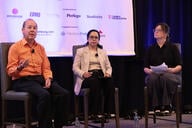You have /5 articles left.
Sign up for a free account or log in.
A new study in PLOS One suggests that structural interventions in Ph.D. programs in the natural and applied sciences may increase publication rates for underrepresented minorities. The study analyzed data from two internal surveys of Ph.D. students at University of California, Berkeley, both of which indicated that underrepresented groups engage in publishing activity at significantly lower rates than more represented male students (the study considers student feedback on whether they’d recently submitted a paper for publication or delivered papers at national scholarly meetings).
The authors argue that such outcomes perpetuate the diversity gap in the STEM fields because publications matter in appointments to postdoctoral and faculty positions. Yet a “conspicuous exception” to their findings was Berkeley’s College of Chemistry, which the study describes as “a highly structured environment in which [students] are introduced to research (via lab rotations) at the outset of their studies, their advisors are regularly and systematically queried as to their students’ progress, and expectations surrounding publication of research results are both implicitly and explicitly clear even in the first two years of study.”
Co-author Rodolfo Mendoza-Denton, Richard and Rhoda Goldman Professor of Psychology and associate dean for diversity and inclusion in the College of Letters and Science at Berkeley, said in an interview that he’s currently engaged in qualitative work to further define the relationship between the chemistry department’s structure on campus and student publication engagement. He nevertheless called the paper’s existing hypothesis that there is a connection “compelling,” and said there’s no reason why chemistry’s more structured approach to Ph.D. education can’t be exported to other disciplines and campuses. “It’s fairly straightforward,” he said, noting that a number of other STEM diversity efforts have attempted to change students' mind-sets or train faculty members to recognize unconscious biases, but few have taken a structural approach. “That’s why we’re so excited about it.”





